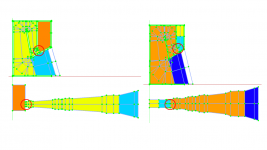What Happen if you remove all parts circled on Red to simplify the design
also remove the angled wood Arc and the 3 piece cut circeld on red also and replace with just one cut of ply
besides ,that 21" PD driver is no longer made so maybe some volume mods to fit another current driver inside.

also remove the angled wood Arc and the 3 piece cut circeld on red also and replace with just one cut of ply
besides ,that 21" PD driver is no longer made so maybe some volume mods to fit another current driver inside.
All those things are waste of space and make the box heavier and bigger.
Last edited:
as you can see in the links below, in the model I implement them, those things were already removed and optimized.
https://freeloudspeakerplan.rf.gd/pages/superscooper1.htm
This model you have rear chamber loaded with horn.
https://freeloudspeakerplan.rf.gd/pages/superscooper2.htm
This one you have Offset driver
If both have the same dimensions will have the same performance but you have different freedom on them and they can be optimized in a different way (thinking)
https://freeloudspeakerplan.rf.gd/pages/superscooper1.htm
This model you have rear chamber loaded with horn.
https://freeloudspeakerplan.rf.gd/pages/superscooper2.htm
This one you have Offset driver
If both have the same dimensions will have the same performance but you have different freedom on them and they can be optimized in a different way (thinking)
you can also check in the post #5 a additional indication.
https://www.diyaudio.com/community/...-better-than-tapped-horn.391782/#post-7161999
Each time you bend, part of the volume will not be taken into account from hornresp simulation and it will not improve the performance in a meaningful way.
People use angled panels inside a horn path in order to avoid a condition for cancelling waves and so improve output performance, but those things are more important above 200Hz. For a subwoofer they make no difference. I can't recall but people already share comparison in a subwoofer to confirm it.
https://www.diyaudio.com/community/...-better-than-tapped-horn.391782/#post-7161999
Each time you bend, part of the volume will not be taken into account from hornresp simulation and it will not improve the performance in a meaningful way.
People use angled panels inside a horn path in order to avoid a condition for cancelling waves and so improve output performance, but those things are more important above 200Hz. For a subwoofer they make no difference. I can't recall but people already share comparison in a subwoofer to confirm it.
That's why i was asking, that design was done in 2001, no hornesp at the time....so how designers of the era calculated the boxes??
Trial and error?
I mean draw...build...measure..
And so on??
Trial and error?
I mean draw...build...measure..
And so on??
Jbell tested corner reflectors in his SS15 thread. Plain and simple, they subtract SPL. If you use them, then you have to increase the size of the original HR model and build.
much better, less hassle and wood to cut 😀Jbell tested corner reflectors in his SS15 thread. Plain and simple, they subtract SPL. If you use them, then you have to increase the size of the original HR model and build.
If You modify, or even if you don't, it would be foolish not to plot the hornpath & then sim with your intended driver - Far more cost effective than guessing.
The fiirst Vee shape behind the driver makes a bandpass chamber for the driver . Removing that would fundamentally change the speaker design. That restriction is definitely there for a reason!
The fiirst Vee shape behind the driver makes a bandpass chamber for the driver . Removing that would fundamentally change the speaker design. That restriction is definitely there for a reason!
So scoopers are BP designs?
I think that all boxes that the driver faces directly to the outside are Direct Radiator as the name suggests and not a BandPass type.
Maybe what Xoc1 refer as bandpass, means the behavior caused by the geometry related to frequency filtering, allowing certain band frequencies to pass and dampening others.
I Don't know if you checked the linked I posted in the post #3 but to make it simple, check attached image, it show two important differences between the SuperScooper1 and SuperScooper2. If you narrow the cross section it will create the chamber as Xoc1 refer, a back-chamber feeding into a Front Horn, a throat behavior, strangulating the air flow. The other one, keeps the cross section constant and so you can see the driver placed in a kind of offset horn fashion. Due to that, the two boxes are modeled in a different way, maybe the results can be very similar, anyone can check and takes conclusion witch works better for a given driver.
Attachments
I think the intent there is to stop midrange frequencies and up from the rear of the speaker from entering and being amplified by the horn section of the enclosure. Note those frequencies could be those present in the signal fed to the woofer or harmonic distortion from the woofer itself. I'm not sure how well that little triangle and that chamber behind it works as such a "muffler" however. Trying to sim it in Hornresp might turn up something interesting.The fiirst Vee shape behind the driver makes a bandpass chamber for the driver . Removing that would fundamentally change the speaker design. That restriction is definitely there for a reason!
Note: the Eminence version of the RLH didn't have any of the fancy triangles or that gap in the center of the horn. Basically lt looks like if someone followed the instructions provided earlier in this thread to improve the horn 🙂. Instead of the triangle, the "bandpass" effect is implemented by restricting the exit from the chamber behind the driver.
- Home
- Loudspeakers
- Subwoofers
- MOGALE PD2150 Super Scooper Mods
